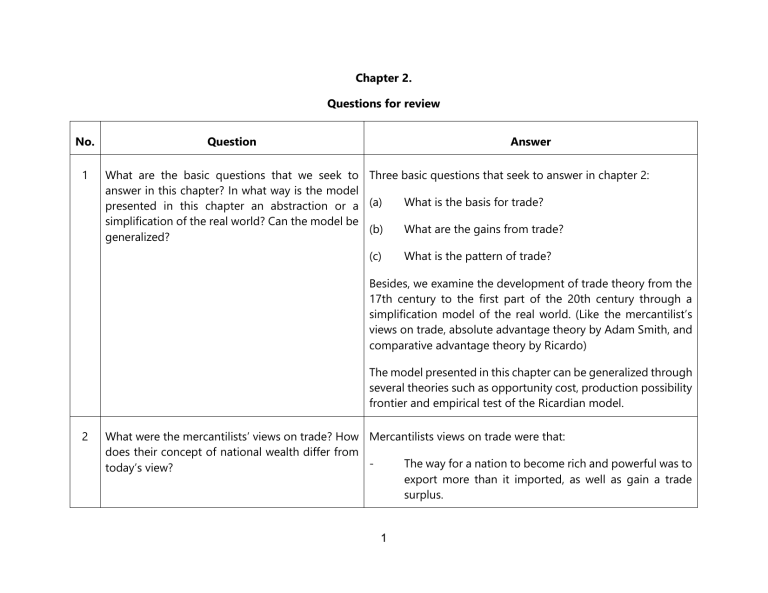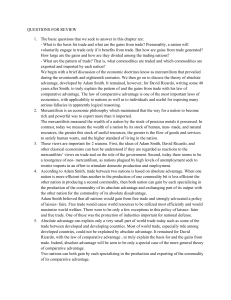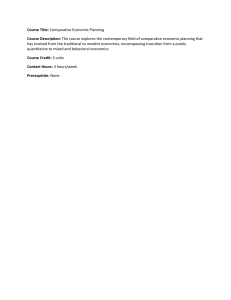
Chapter 2. Questions for review No. 1 Question Answer What are the basic questions that we seek to Three basic questions that seek to answer in chapter 2: answer in this chapter? In what way is the model What is the basis for trade? presented in this chapter an abstraction or a (a) simplification of the real world? Can the model be (b) What are the gains from trade? generalized? (c) What is the pattern of trade? Besides, we examine the development of trade theory from the 17th century to the first part of the 20th century through a simplification model of the real world. (Like the mercantilist’s views on trade, absolute advantage theory by Adam Smith, and comparative advantage theory by Ricardo) The model presented in this chapter can be generalized through several theories such as opportunity cost, production possibility frontier and empirical test of the Ricardian model. 2 What were the mercantilists’ views on trade? How Mercantilists views on trade were that: does their concept of national wealth differ from The way for a nation to become rich and powerful was to today’s view? export more than it imported, as well as gain a trade surplus. 1 - The wealth of the nation could be measured by an inflow of bullion, or precious metals, primarily gold and silver. - The more gold and silver a nation had, the richer and more powerful it was. Modern trade views are way different than mercantilist’s trade view that: 3 - The wealth of a nation is measured by its stock of human (human capital, labor), man-made, capital (direct& indirect), investment (public & private), and natural resources available for producing goods and services. - The greater this stock of useful resources, the greater is the flow of goods and services to satisfy human wants, and the higher standard of living of the nation. Why is it important to study the mercantilists’ views on trade? How were their views different from those of Adam Smith? What is the relevance of all this today? It is crucial to study the mercantilist’s views on trade because of: 2 + The ideas of classical economists can best be understood if they are regarded as reactions to the mercantilists’ views on trade and on the role of government. + In today’s world, there seems to be a resurgence of neo-mercantilism, as nations plagued by high levels of unemployment seek to restrict imports to stimulate domestic production and employment. - Smith’s views about trade are different from the mercantilist’s views that: - + Trade between two nations is based on absolute advantage. + While the mercantilists believed that one nation could gain only at the expense of another nation and advocated strict government control of all economic activity and trade, Adam Smith (and the other classical economists who followed him) believed that all nations would gain from free trade and strongly advocated a policy of laissezfaire (i.e., as little government interference with the economic system as possible). + Free trade would cause world resources to be utilized most efficiently and would maximize world welfare. There were to be only a few exceptions to this policy of laissez-faire and free trade. Absolute advantage is still relevant in today’s world that: + 3 Most nations impose many restrictions on the free flow of international trade. Trade restrictions are invariably rationalized in terms of national welfare. Trade restrictions are advocated by the few industries and their workers who are hurt by imports. As such, trade restrictions benefit the few at the expense of the many (who will have to pay higher prices for competing domestic goods). + 4 What was the basis for and the pattern of trade according to Adam Smith? How were gains from trade generated? What policies did Smith advocate in international trade? What did he think was the proper function of government in the economic life of the nation? Smith’s theory served the interest of factory owners (who were able to pay lower wages because of cheaper food imports) and harmed landowners in England (because food became less scarce due to cheaper imports), and it shows the link between social pressures and the development of new economic theories to support them. According to A. Smith’s theory, trade between two nations is based on absolute advantage. Smith started with the simple truth that for two nations to trade with each other voluntarily, both nations must gain. If one nation gained nothing or lost, it would simply refuse to trade. - Adam Smith’s theory: + 4 When one nation is more efficient than (or has an absolute advantage over) another in the production of one commodity but is less efficient than (or has an absolute disadvantage with respect to) the other nation in producing a second commodity, then both nations can gain by each specializing in the production of the commodity of its absolute advantage and exchanging part of its output with the other nation for the commodity of its absolute disadvantage. + - By this process, resources are utilized in the most efficient way, and the output of both commodities will rise. Gains from trade can be generated by: + - The increase in the output of both commodities measures the gains from specialization in production available to be divided between the two nations through trade. The policies that A. Smith advocates: + - All nations would gain from free trade and strongly advocated a policy of laissez-faire (i.e., as little government interference with the economic system as possible). The main function of the government in the economic life of the nation that A. Smith thought about is: + 5 The protection of industries important for national defense. 5 In what way was Ricardo’s law of comparative advantage superior to Smith’s theory of absolute advantage? How do gains from trade arise with comparative advantage? How can a nation that is less efficient than another nation in the production of all commodities export anything to the second nation? 6 Problems: 1. Table 2.5 shows bushels of wheat and yards of cloth that the United States and the United Kingdom can produce with one hour of labor time under four different hypothetical situations. In each case, identify the commodity in which the United States and the United Kingdom have an absolute advantage or disadvantage. Case A: - The US has an absolute advantage over the UK in wheat production. - The UK has an absolute advantage over the US in cloth production. Case B: - The US has an absolute advantage over the UK in both commodities - The UK has an absolute disadvantage in both commodities. Case C: - The US has an absolute advantage over the UK in wheat production. 7 - Neither of these nations has an absolute advantage in cloth production. Case D: - The US has an absolute advantage over the UK in both commodities. - The UK has an absolute disadvantage in both commodities. 2. With respect to Table 2.5, indicate in each case the commodity in which each nation has a comparative advantage or disadvantage. Case A. The US The UK In 1 hour of production 4W=1C ->1W=1/4C 1W=2C Comparative price of wheat PW/PC = 1/4 PW/PC = 2 Comparative price of cloth PC/PW= 4 PC/PW=1/2 - The US has a comparative advantage over the UK in wheat production - The UK has a comparative advantage over the US in cloth production. -> The US should export wheat, import cloth -> The UK should export cloth, import wheat. 8 Case B The US The UK In 1 hour of production 4W=3C ->1W=3/4C 1W=2C Comparative price of wheat PW/PC = 3/4 PW/PC = 2 Comparative price of cloth PC/PW= 4/3 PC/PW=1/2 - The US has a comparative advantage over the UK in wheat production - The UK has a comparative advantage over the US in cloth production Case C The US The UK In 1 hour of production 4W=2C ->1W=1/2C 1W=2C Comparative price of wheat PW/PC = 1/2 PW/PC = 2 9 Comparative price of cloth PC/PW= 2 - The US has a comparative advantage over the UK in wheat production - The UK has a comparative advantage over the US in cloth production. PC/PW=1/2 Case D The US The UK In 1 hour of production 4W=2C ->1W=1/2C 2W=1C -> 1W =1/2C Comparative price of wheat PW/PC = 1/2 PW/PC = 1/2 Comparative price of cloth PC/PW= 2 PC/PW=2 - The US and the UK has a comparative advantage in neither commodity. 3. With respect to Table 2.5, indicate in each case whether or not trade is possible and the basis for trade. Case A: Trade is based on absolute advantage. Case B: Trade is based on comparative advantage. Case C: Trade is based on comparative advantage. Case D: No trade is possible (both commodities have the same ratio in both absolute and comparative advantage) 10 4. Suppose that in Case B in Table 2.5 the United States exchanges 4W for 4C with the United Kingdom. (a) How much does the United States gain in terms of cloth? The US gains 1C (b) How much does the United Kingdom gain in terms of cloth? The UK gains (c) What is the range for mutually beneficial trade? (d) How much would each nation gain if they exchanged 4W for 6C instead? 11


